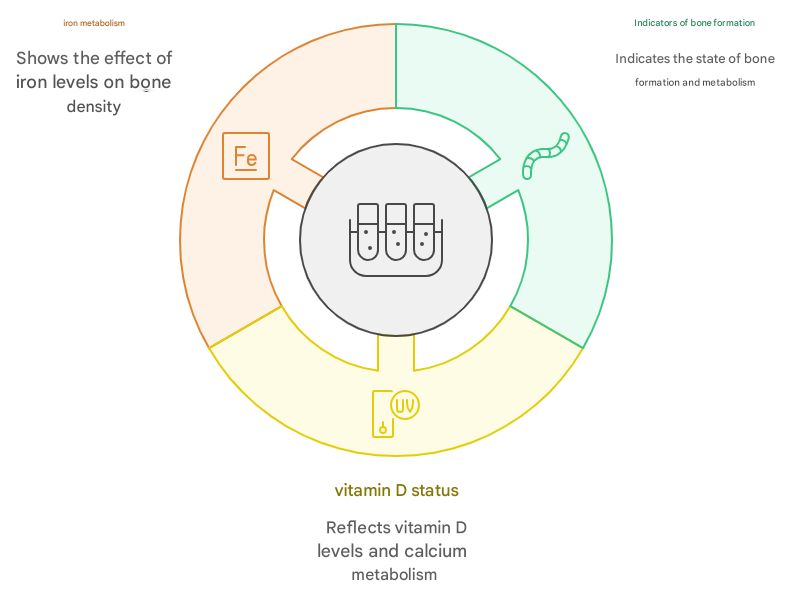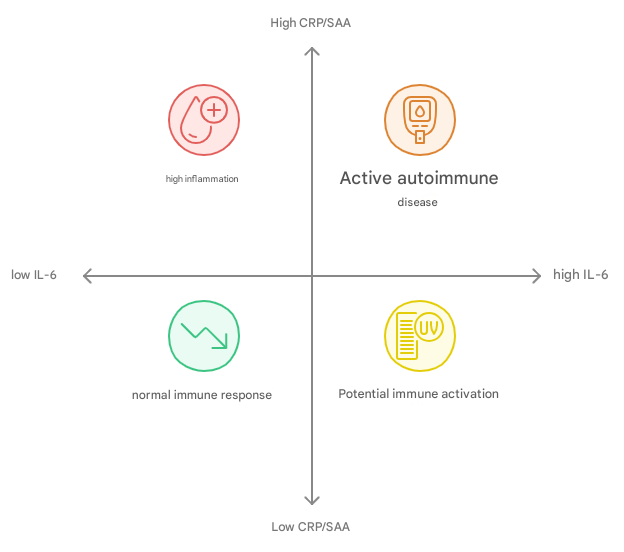Combination of Tests
By combining NT-proBNP, CK-MB, Heart-type Fatty Acid-Binding Protein (H-FABP), and D-Dimer, it is possible to comprehensively assess the risks of heart failure, myocardial infarction, and thrombosis.
- NT-proBNP is used as an indicator of heart failure, showing if there is strain on the heart.
- CK-MB and H-FABP are markers of myocardial damage, making them useful in diagnosing myocardial infarction.
- D-Dimer is used to assess the risk of blood clot formation and helps predict the occurrence of cardiovascular events.

Combining CRP, Procalcitonin (PCT), Serum Amyloid A (SAA), and Interleukin-6 enables a more detailed diagnosis of bacterial infections and systemic inflammation levels.
- CRP and SAA increase when inflammation occurs, making them suitable for assessing inflammation levels.
- PCT serves as a biomarker for inflammation due to bacterial infection and is useful in the early diagnosis of severe infections.
- Interleukin-6 activates the immune response, indicating the degree of systemic inflammation or infection.

By combining urinary microalbumin (MAU), Myeloperoxidase (MPO), and Creatine Kinase-MB (CK-MB), kidney disease risk can be evaluated.
- MAU is used as an early indicator of kidney dysfunction, making it useful for assessing kidney disease risk.
- MPO is associated with atherosclerosis and cardiovascular diseases, serving as an indicator of inflammation and oxidative stress.
- CK-MB may also indicate the impact of kidney function decline.

Combining Ferritin, 25-Hydroxyvitamin D, and Retinol-Binding Protein (RBP) aids in assessing bone metabolism and nutritional status.
- Ferritin indicates iron storage status and fluctuates with anemia or inflammation.
- 25-Hydroxyvitamin D reflects vitamin D levels and is useful for assessing bone density and immune function.
- RBP is related to vitamin A metabolism and reflects nutritional status.

Combining Anti-Müllerian Hormone (AMH), Gastrin-17 (G-17), and Interleukin-6 provides a comprehensive evaluation of gastrointestinal and endocrine abnormalities.
- AMH is used to assess ovarian function and fertility risk.
- G-17 is related to gastric acid secretion and digestive function assessment and indicates Helicobacter pylori infection risk.
- Interleukin-6 also plays a role in the endocrine system.

By combining Myeloperoxidase (MPO), Lipoprotein-Associated Phospholipase A2 (Lp-PLA2), and Heart-type Fatty Acid-Binding Protein (H-FABP), a comprehensive assessment of atherosclerosis progression and oxidative stress impact is possible.
- MPO is involved in inflammation and oxidative stress and suggests atherosclerosis progression.
- Lp-PLA2 breaks down oxidized LDL, making it useful for atherosclerosis risk assessment.
- H-FABP is also associated with oxidative stress, making it useful for cardiovascular risk assessment due to oxidative stress.

Combining Ferritin, CRP, and Interleukin-6 helps predict inflammation and fatty liver risks in the liver, aiding in early detection of liver dysfunction.
- Ferritin is associated with iron metabolism and is useful in assessing liver dysfunction or inflammation.
- CRP and Interleukin-6 are markers of inflammation, useful in evaluating chronic liver inflammation, fatty liver, and hepatitis.

Combining Collagen Type I Amino-Terminal Propeptide, 25-Hydroxyvitamin D, and Ferritin aids in assessing bone density reduction and osteoporosis risk.
- Collagen Type I Amino-Terminal Propeptide is an indicator of bone formation and reflects bone metabolism status.
- 25-Hydroxyvitamin D reflects vitamin D levels, aiding in bone density and calcium metabolism assessment.
- Ferritin is related to iron metabolism, as iron deficiency may impact bone density.

Combining Interleukin-6, CRP, and Serum Amyloid A (SAA) allows for assessing excessive immune response or autoimmune disease progression.
- Interleukin-6 stimulates the immune system and is used to assess autoimmune disease activity.
- CRP and SAA are markers of acute-phase reactions, indicating inflammation and immune activity levels.

By combining Gastrin-17 (G-17), Pepsinogen I (PG I), and Pepsinogen II (PG II), the health of the digestive system, gastric mucosal protection, and presence of Helicobacter pylori infection can be assessed.
- G-17 is an indicator of gastric acid secretion and digestive function, used to assess gastritis, hyperacidity, and Helicobacter pylori infection risk.
- PG I and PG II indicate gastric mucosal health and the progression of atrophic gastritis, aiding in assessing stomach health and nutritional absorption.

By combining Anti-Müllerian Hormone (AMH) and Adiponectin, it is possible to assess fertility potential, ovarian health, and metabolic function.
- AMH is used to evaluate ovarian function and follicle status, serving as an indicator of reproductive capacity.
- Adiponectin is a hormone from fat cells involved in endocrine metabolism, helping in comprehensive assessment of fertility and metabolic status.

Combining Collagen Type I Amino-Terminal Propeptide, 25-Hydroxyvitamin D, and Ferritin allows for a comprehensive assessment of skin firmness, radiance, and elasticity, supporting healthy skin from within.
- Collagen Type I Amino-Terminal Propeptide is an indicator of collagen production, aiding in assessing skin elasticity and firmness.
- 25-Hydroxyvitamin D reflects vitamin D levels and impacts skin turnover and immune function.
- Ferritin indicates iron metabolism, with iron deficiency affecting skin tone and color, making it useful for nutritional assessment.

Combining Myeloperoxidase (MPO), Lipoprotein-Associated Phospholipase A2 (Lp-PLA2), and Serum Amyloid A (SAA) provides a comprehensive evaluation of oxidative stress and inflammation, aiding in health management for aging prevention.
- MPO is an indicator of oxidative stress, indicating aging risks due to oxidation and skin issues.
- Lp-PLA2 is also related to oxidative stress, showing risks of damage to skin and blood vessels from oxidized lipids.
- SAA is an indicator of inflammation, useful for assessing aging risks due to chronic inflammation.

Combining Anti-Müllerian Hormone (AMH), Adiponectin, and Interleukin-6 helps assess the impact of hormone balance on skin health, aiding in beauty management.
- AMH is used to evaluate ovarian function and hormone balance, as imbalances may affect skin and hair health, potentially leading to issues such as infertility or hormonal fluctuations.
- Adiponectin is secreted from fat cells and is closely related to hormone balance and visceral fat, impacting metabolism and skin condition from a beauty perspective.
- Interleukin-6 is an inflammation marker that may indicate a tendency for skin issues like acne or blemishes due to hormonal imbalances.

By combining Ferritin, 25-Hydroxyvitamin D, and Retinol Binding Protein (RBP), you can assess hair and nail health, which is beneficial in preventing hair loss and brittle nails.
- Ferritin indicates iron storage levels, and low iron can lead to thinning hair or hair loss, making it essential for hair health management.
- 25-Hydroxyvitamin D is involved in calcium absorption, which impacts the strength of hair and nails; deficiency may lead to brittle nails or finer hair.
- RBP is related to Vitamin A metabolism, crucial for skin and hair health. Low Vitamin A can lead to dryness and itchiness.

Evaluating Ferritin, 25-Hydroxyvitamin D, Retinol Binding Protein (RBP), and Adiponectin provides insights into the impact of nutritional status on beauty, identifying components to supplement through diet or vitamins.
- Ferritin and RBP respectively assess iron and Vitamin A levels, which are essential for skin radiance and the strength of nails and hair.
- 25-Hydroxyvitamin D reflects Vitamin D levels, which play a role in immune health and skin vitality.
- Adiponectin, secreted from fat cells, helps maintain nutritional and metabolic balance, contributing to healthy skin and body shape.

